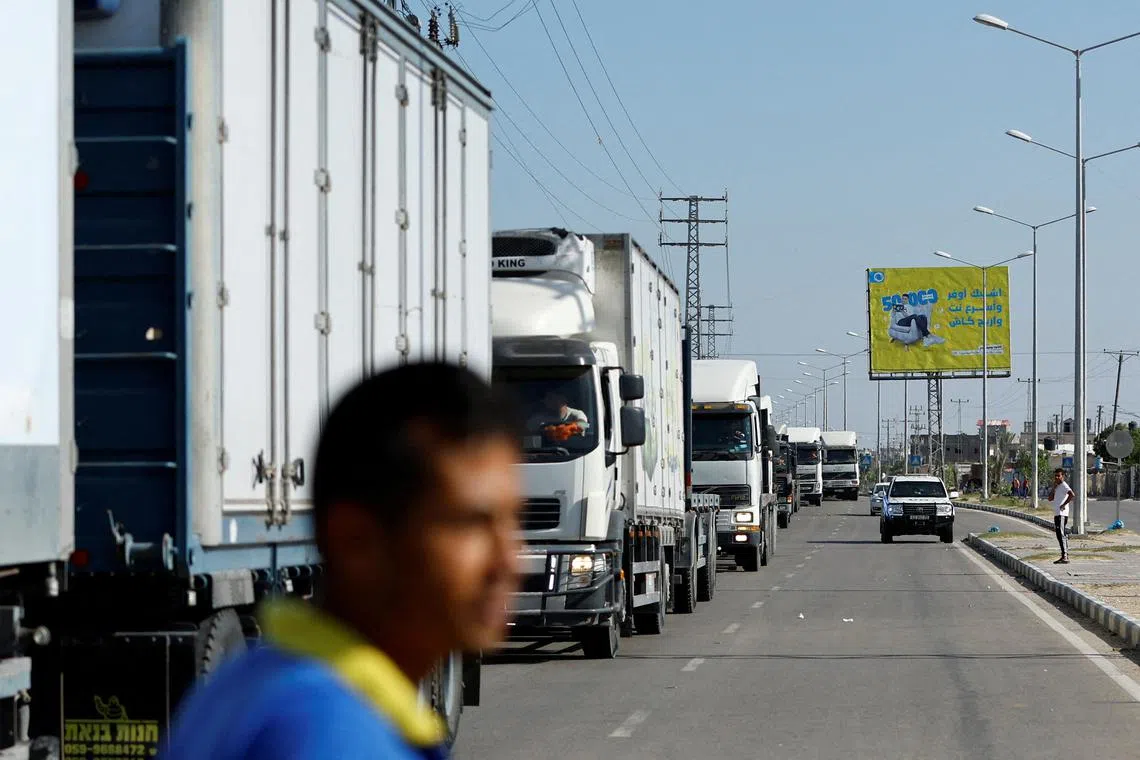Gaza’s displaced population shows signs of disease from crowding, poor sanitation
Sign up now: Get ST's newsletters delivered to your inbox

Women take shelter inside a UN-run school as Israeli forces continue a blockade around the Gaza Strip.
PHOTO: REUTERS
Follow topic:
GAZA – Doctors in Gaza say patients arriving at hospitals are showing signs of disease caused by overcrowding and poor sanitation after more than 1.4 million people fled their homes
Aid agencies have repeatedly warned of a health crisis in the tiny, crowded Palestinian enclave under an Israeli blockade that has cut off electricity, clean water and fuel
“The crowding of civilians and the fact that most schools used as shelters are housing lots of people, it’s a prime breeding ground for disease to spread,” said Dr Nahed Abu Taaema, a public health doctor at Nasser Hospital in Khan Younis.
The Palestinian authorities say nearly 5,800 people have been killed by Israeli air and artillery strikes that followed the Oct 7 attack by Hamas militants
Israel has told everybody living in the northern half of the 45km long Gaza Strip to move south, but its strikes have flattened districts throughout the enclave
With all hospitals running out of fuel to power their generators, doctors have warned that critical equipment, like incubators for newborns, risk stopping.
The Hamas-run Health Ministry said 40 medical centres have suspended operations at a time when the bombardment and displacement are putting increased stress on the system.
The World Health Organisation warned that a third of Gaza hospitals were not operating.
“We are on our knees asking for that sustained, scaled up, protected humanitarian operation,” said WHO regional emergencies head Rick Brennan.
The private Indonesian Hospital, the biggest in north Gaza, said on Tuesday it switched off everything except the last vital departments such as the intensive care unit.
The only other hospital that was still serving patients in northern Gaza, Beit Hanoun Hospital, stopped operations because of the intense bombardment of the town, the Palestinian Health Ministry said.
“If the hospital doesn’t get fuel, this is going to be a death sentence against the patients in northern Gaza,” said Dr Atef al-Kahlout, the hospital’s director.
‘The children are all sick’
In the temporary shelters where displaced Palestinians are crowding with their families hoping for safety from the bombs, people are starting to suffer from stomach complaints, lung infections and rashes, said Dr Abu Taaema of Nasser Hospital.
“It’s hot in the tent under the midday sun and there are insects and flies… At night it’s cold and there aren’t enough blankets for everyone. The children are all sick. Some are coughing, some have runny noses, some have fevers at night,” said Ms Sojood Najm, a woman staying at a UN shelter.

Trucks head to the Egyptian side of the border to be loaded with aid that will be delivered to Palestinians in Gaza.
PHOTO: REUTERS
She fled her home in Gaza City with her husband and three children and they have been living in a tent for nine days, unable to bathe.
“Every day, I cry to my mother,” said Ms Najm.
At a pharmacy, the owner said there were few stores left. People have stockpiled over-the-counter medicines, but there are concerns that treatments for chronic illnesses may run out.
With electricity cut off, many people gathered at a petrol station equipped with solar panels in order to charge their phones, but it was hit by an air strike overnight, killing several people, said a neighbour, Mr Abdallah Abu al-Atta.

Palestinians search for bodies and survivors in the rubble of a residential building leveled in an airstrike, in the southern Gaza Strip, on Oct 21.
PHOTO: EPA-EFE
Israel said it killed dozens of Hamas fighters in strikes overnight, one of the most intense bombardments since the war began, but that it would take time to achieve its aim of destroying the militant group.
Since the last major warfare between Israel and Hamas, the group has grown more adept at urban warfare. Unlike in some previous wars, Hamas fighters are very rarely seen on the streets, operating instead almost entirely from under cover. REUTERS

